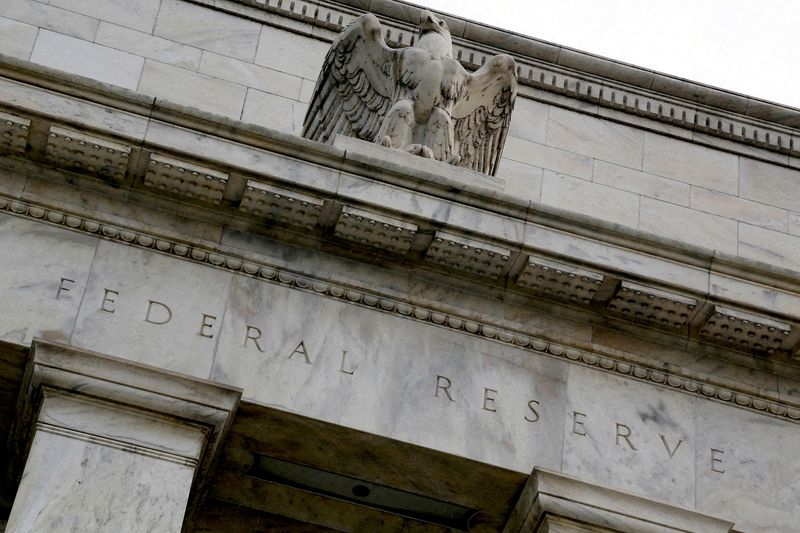(This April 24 story has been corrected to fix the spelling of a name to Mahmood, not Mahmoud, in section 4)
By Naomi Rovnick, Yoruk Bahceli and Dhara Ranasinghe
LONDON (Reuters) - As calm returns to markets roiled by banking havoc in March, it's time to reflect on the policy response.
The International Monetary Fund has warned of a "perilous combination of vulnerabilities" in markets. The Bank of International Settlements says for the first time since World War Two that central banks are dealing with surging inflation coinciding with very high debt levels, threatening economic stability.
"The risks to the financial system are not as pressing as they were in March but that doesn't mean the crisis has passed," said Northern Trust chief economist Carl Tannenbaum, who worked in the Fed's risk section during the 2008 global financial crisis.
Here, experts weigh in on what policymakers did well in March with takeaways for the future.
Central banks' dilemma https://www.reuters.com/graphics/GLOBAL-MARKET/xmpjkjdebvr/Screenshot%202023-04-18%20at%2016.37.56.png
1/ STICK WITH THE PLAN
The Federal Reserve and the European Central Bank continued hiking rates in March as Silicon Valley Bank (SVB) failed and Credit Suisse (SIX:CSGN) (CS) was forced to merge with UBS.
Rapid rate rises after years of ultra-low rates have caused pain. But changing course as markets slid could have exacerbated that.
"If they hadn't have done those rate increases, there was a danger that people would look at that and say, oh, my god, the situation is even worse than we thought it was," said Dario Perkins, managing director, global macro at TS Lombard and a former advisor to Britain's Treasury.
A measure of volatility in the Treasury market has eased after hitting its highest level since 2008 in March.
Low and stable inflation is good for markets and the economy, so central banks had to show their seriousness on inflation, Tannenbaum added.
U.S. bonds volatility https://www.reuters.com/graphics/USA-BONDS/akveqxzrqvr/Screenshot%202023-04-21%20at%2011.47.44.png
2/ LOUD AND CLEAR
After staying the course comes selling the message.
The Fed met just 12 days after the SVB failure and the ECB's March 16 meeting was two days before Credit Suisse's rescue. U.S. regional bank stocks tanked 36% in March.
Central banks softened rate rises with communication that was mindful of instability risks, showing reassuring "humility", said Perkins.
Not all communication has been stellar.
The Swiss National Bank said on March 15 Credit Suisse met capital and liquidity requirements.
"And then days later Credit Suisse was gone," said Gael Combes, head of fundamental research at Swiss fund manager Unigestion.
That reversal highlighted prospects of central bankers being "caught on the back foot," Combes said.
Aggressive tightening may still create another financial crisis, said Dartmouth economics professor and former Bank of England rate setter David Blanchflower.
U.S. banks face borrowers defaulting on car loans and student debt, while UK mortgage borrowers rolling off cheap fixed rate loans onto more expensive deals could spark defaults, Blanchflower added. "The tentacles," of bank failures, he said, "are much longer than folks think."
3/ TAKE THE PAIN
The 2008 crisis prompted global efforts to stop taxpayers funding bailouts of troubled banks.
Credit Suisse's rescue took the pain elsewhere, as Swiss regulators ruled holders of the bank's Additional Tier 1 bonds, a shock absorber against losses, would be wiped out. Shareholders got $3.3 billion.
Former ECB chief economist Peter Praet said the success of CS's rescue was shown by turmoil not spreading to other banks and creditors bearing the cost to a large extent, which was "very rare" for a systemic institution.
But lenders are uncertain about holding AT1s, putting the idea of shock absorbing capital buffers at risk.
"The bank resolution framework created after the great financial crisis," said Francesco Papadia, senior fellow at Bruegel and former ECB director general for market operations, "is proving difficult to implement."
CoCo crisis https://www.reuters.com/graphics/GLOBAL-MARKETS/klpygbkompg/chart.png
4/ UNITED WE STAND
After CS's rescue, the Fed and other big central banks supported market liquidity with dollar swap lines. Keeping the global reserve currency flowing, in an effort not seen since the 2020 COVID-pandemic, likely prevented fears of international institutions dumping U.S Treasuries to secure dollars or foreign central banks becoming unable to deliver dollars, experts said.
"It comforts the market," said Mahmood Pradhan, global head of macro at Amundi Institute and former deputy director of the IMF's European department. "Often the amount of the facility extended is not needed, but it's a safety measure," he said.
The race to raise rates https://www.reuters.com/graphics/GLOBAL-MARKETS/lbvggjjagvq/chart.png
5/ MORAL HAZARD
In the U.S. the Fed, the Treasury and the Federal Deposit Insurance Corporation took the rare decision to give SVB's customers access to all non-insured deposits.
Political backlash followed, with Republicans opposing universal deposit guarantees on the basis such tools encourage moral hazard.

Amundi's Pradhan said the "case by case" central bank responses to individual lenders failing in March exposed the lack of a coordinated bank resolution system.
"We've seen very little resolution of how to wind down a bank," he said. "What we have not resolved is the resolution system itself."